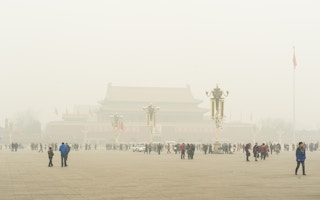As the burners are fired up at full blast to stave off the biting winter cold, Beijing and its surrounding area started the New Year engulfed in smog.
In a replay of a similar situation in early December 2015 and just before the holiday period in December 2016, schools and some industries have been ordered closed, hundreds of flights grounded, and vehicle bans ordered on the roads.
But while these ‘airpocalypses’, as they are dubbed by the press, threaten lives and health, they at least focus attention on a challenge that residents in the national capital region of the People’s Republic of China (PRC)—as well as other parts of Asia—are living with day in, day out.
During the red alerts, air quality in Beijing does indeed reach worrying levels. The level of harmful particulate matter, dubbed PM2.5 by the World Health Organization (WHO), was recorded at exceeding 500 micrograms per cubic metre. The WHO sets a safe standard of not more than 25 micrograms per cubic metre in a 24-hour period, while the PRC sets a standard of 75 micrograms per cubic metre.
Amid these well publicised smogs, we should not lose sight of the fact that residents are potentially in harm’s way the whole year round. Almost 228 million residents are living daily with particulate levels much higher than is safe.
High concentrations of PM2.5 cause about 1 million deaths annually in the PRC, wiping about 7.5 per cent off the national gross domestic product.
Given the health threat and the case for tackling the region’s air quality, the issue is urgent. The restrictive measures being taken to ease the smog will help but are little more than a face mask on a much wider problem embracing Beijing-Tianjin-Hebei (BTH) and beyond.
Underlying the poor air quality are a heavy reliance on coal for energy in the region, a high concentration of polluting enterprises in the areas surrounding Beijing, and the heavy volume of vehicles on the roads.
Much of the challenge centres on Hebei province, the country’s second largest coal user, which relies heavily on polluting industries such as coal-fired energy generation, iron, steel, cooking, and cement. The province produces more than 80 per cent of total primary PM2.5 in the BTH region, and three times more sulfur dioxide and nitrogen oxides than the total of Beijing and Tianjin.
Tackling Hebei’s whole industrial structure is therefore a priority when it comes to improving coordination of air quality improvement efforts in the region.
The PRC government has committed to improving the air quality in the capital region. And some progress has been made. There are new ambient air quality standards and a nationwide action plan.
But pollution reduction efforts resulted only in several short-term ‘end-of-pipe’ policy actions like strengthening legal enforcement against polluting industries and the number of old vehicles. Sustained, coordinated efforts embracing many different sectors and layers of government over different regions are needed to make a real difference.
Action to combat air pollution also has to recognise that it is not purely an urban issue. For example, agricultural activities such as biomass burning and rural energy consumption are together responsible for 15 per cent of the region’s PM2.5 emissions.
Similarly, small and medium-sized enterprises (SMEs) have a key role to play, since they account for about 60 per cent of industrial pollution in the capital region. But they lack the expertise, the experience, and understanding to make use of advanced and more efficient technologies. More important is the fact that, even if SMEs have this awareness, they lack access to credit.
“
Beijing is now moving in the right direction, as authorities recognise the need to go beyond short-term pollution control and commit to develop a solid policy basis for improvement, while maintaining robust socioeconomic development.
These are areas where the Asian Development Bank is trying to help. At the request of the PRC, ADB plans a half a billion dollars in assistance to clean up the BTH region’s air every year until 2020. Its first assistance in this series, approved in December 2016, is setting up a green financing platform for BTH to provide credit and financing to industrial projects with potential for energy saving and pollution reduction.
The platform will mobilise about US$3.8 billion in domestic financing for long-term, coordinated efforts in the energy, transport, urban, and agriculture sectors. It follows a first loan of US$300 million approved in 2015 to Hebei Province to put in place appropriate policies cofinanced by the German development bank KfW as part of a more than US$4 billion programme.
The ADB assistance over the coming five years will focus on strengthening policies and the regulatory framework, unlocking investment in areas in need, and promoting new technologies in key sectors. As a logical next step, advanced best available, low-carbon least polluting technologies will be introduced to make them cleaner.
Overall, ADB’s assistance is expected to catalyse more than US$20 billion of additional resources to tackle air pollution issues in the BTH region.
Even with these investments, however, Beijing’s air quality challenges are not going to disappear overnight. But the capital region is now moving in the right direction, as authorities recognise the need to go beyond short-term pollution control and commit to develop a solid policy basis for improvement, while maintaining robust socioeconomic development. Hopefully, clear blue skies will soon be on their way back to Beijing.
Lin Lu is Energy Specialist, East Asia Regional Department at the Asian Development Bank. This post is republished from the ADB blog.


















